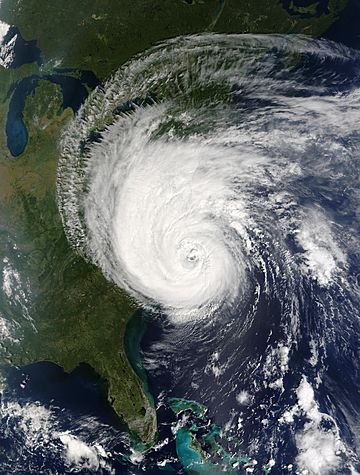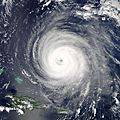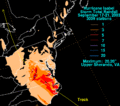Hurricane Isabel facts for kids
| Category 5 major hurricane (SSHWS/NWS) | |

Hurricane Isabel approaching North Carolina's Outer Banks
|
|
| Formed | September 6, 2003 |
|---|---|
| Dissipated | September 20, 2003 |
| Highest winds | 1-minute sustained: 165 mph (270 km/h) |
| Lowest pressure | 915 mbar (hPa); 27.02 inHg |
| Fatalities | 16 direct, 35 indirect |
| Damage | $3.6 billion (2003 USD) |
| Areas affected | Greater Antilles, Bahamas, North Carolina, Virginia, Maryland, South Carolina, West Virginia, Delaware, New Jersey, New York, Pennsylvania, Ohio, Ontario, Washington, D.C. |
| Part of the 2003 Atlantic hurricane season | |
Hurricane Isabel was a very strong and damaging storm. It was the most expensive and deadliest hurricane during the 2003 Atlantic hurricane season. Isabel was the ninth named storm and the second major hurricane that year.
It started as a tropical wave in the Atlantic Ocean. Isabel grew stronger and stronger. On September 11, its winds reached 165 mph (265 km/h). After getting weaker and then stronger again for four days, Isabel slowly lost some power. It hit the Outer Banks in North Carolina on September 18. At that time, its winds were about 105 mph (165 km/h). Once it moved over land, it quickly became much weaker.
Contents
Isabel's Journey and Strength
Hurricane Isabel began forming on September 6, 2003. It started from a tropical wave, which is like a ripple in the atmosphere. This wave moved across the tropical Atlantic Ocean. As it traveled, it gathered strength.
Growing into a Major Hurricane
Isabel became a hurricane on September 7. It kept getting stronger very quickly. By September 11, it reached its top strength. It was a Category 5 hurricane with winds of 165 mph (265 km/h). This made it one of the most powerful hurricanes ever seen.
Weakening Before Landfall
After being very strong, Isabel started to weaken. It moved towards the United States. On September 18, it made landfall. It hit the Outer Banks of North Carolina. At this point, its winds were about 105 mph (165 km/h). This was still a very powerful storm.
Impact and Damage
Hurricane Isabel caused a lot of damage. It affected many states along the East Coast. The storm surge was a big problem. This is when the ocean water rushes onto land.
Damage in North Carolina
In North Carolina, the storm surge was very strong. It washed away part of Hatteras Island. This new waterway was sometimes called Isabel Inlet. Many homes on the Outer Banks were damaged or completely destroyed.
Impact in Virginia
The state of Virginia was hit the hardest. The Hampton Roads area saw a lot of damage. Homes along the James River also suffered greatly. Virginia had the most deaths and damage from Hurricane Isabel. About 64% of all the damage happened in North Carolina and Virginia. Also, 68% of the deaths were in these two states.
Widespread Effects
Damage from Isabel reached far up the Atlantic coast. It even went as far west as West Virginia. About six million homes and businesses lost power. This happened across the eastern United States. Rain fell from South Carolina all the way to Maine. It also reached westward into Michigan.
Cost and Lives Lost
The total damage from Hurricane Isabel was huge. It was estimated to be about $3.6 billion in 2003. This would be about $4.1 billion in 2008 money. The hurricane directly caused 16 deaths in seven different states. Another 35 deaths in six states and one Canadian province were indirectly related to the storm.
|
Tropical cyclones of the 2003 Atlantic hurricane season |
|||||||||||||||||||||||||||||||||||||
|
|
||||||||||||||||||||||||||||||||||||
|
|
|||||||||||||||||||||||||||||||||||||
Images for kids
-
The eye of Hurricane Isabel as seen from the International Space Station
-
Hurricane Isabel as seen from the International Space Station
-
Hurricane Isabel making landfall in North Carolina on September 18
-
Flood waters at Langley AFB in Hampton, Virginia after Hurricane Isabel
-
Hurricane Isabel's leftover storm clouds over the Northeastern United States on September 19
See also
 In Spanish: Huracán Isabel para niños
In Spanish: Huracán Isabel para niños









